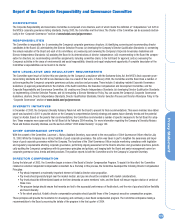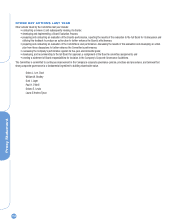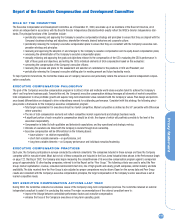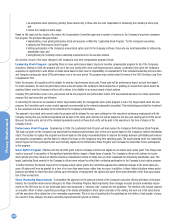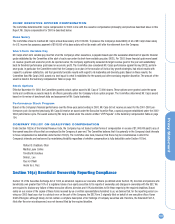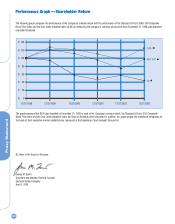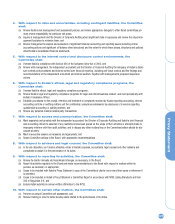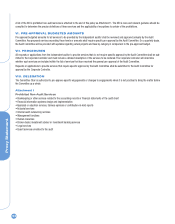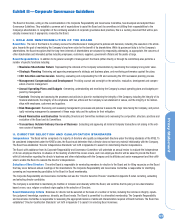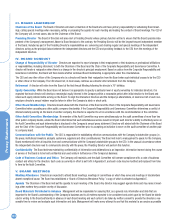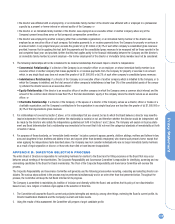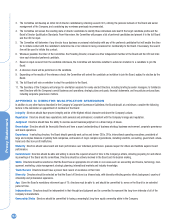Kodak 2003 Annual Report Download - page 124
Download and view the complete annual report
Please find page 124 of the 2003 Kodak annual report below. You can navigate through the pages in the report by either clicking on the pages listed below, or by using the keyword search tool below to find specific information within the annual report.
Proxy Statement
124
(g) Obtain and review, at least annually, the independent accountant’s report describing: the independent accountant’s internal quali-
ty-control procedures; any material issues raised by the most recent internal quality-control review, or peer review, of the inde-
pendent accountant, or by any inquiry or investigation by governmental or professional authorities, within the preceding five
years, respecting one or more independent audits carried out by the independent accountant; any steps taken to deal with the
issues; and all relationships between the independent accountant and Kodak; and
(h) Set policies regulating the hiring of employees and former employees of the independent accountant.
2. With respect to the internal auditors, the Committee shall:
(a) Serve as the Board’s avenue of communication with the Director of Corporate Auditing;
(b) Review and approve the appointment, replacement, reassignment or dismissal of the Director of Corporate Auditing;
(c) Confirm and assure the independence of the internal auditors, and that no attempts have been made to improperly influence the
performance of their audit functions;
(d) Review the annual audit plan of the internal auditors, its scope and the intended level of support for and coordination with the
external audit process; and
(e) Review periodically internal audit activities, staffing and budget to assure the appropriate level of resources is available.
3. With respect to Kodak’s financial disclosures and statements, the Committee shall:
(a) Inquire of management and the independent accountant as to:
(i) The acceptability and appropriateness of financial accounting principles, policies and disclosures, used or proposed by
Kodak, including analysis of the effects of all material alternative GAAP methods on financial statements;
(ii) Management’s quarterly evaluation of the adequacy of Kodak’s system of disclosure controls and procedures; and
(iii) The adequacy of Kodak’s system of internal controls, including whether there are significant deficiencies or material weak-
nesses in the design or operation of internal controls or any fraud involving employees with significant roles in Kodak’s sys-
tem of internal controls. In this regard, the Committee shall oversee management’s assessment of Kodak’s system of internal
controls over financial reporting pursuant to Section 404 of the Sarbanes-Oxley Act and management’s certification process-
es under Sections 302 and 906 of the Sarbanes-Oxley Act. The Committee shall also ensure that management appropriately
addresses any significant deficiencies or material weaknesses that are communicated.
(b) Perform the following with respect to the Company’s consolidated financial statements:
(i) Review with management and the independent accountant:
- Significant financial reporting issues and judgments made in connection with the preparation of the Company’s consolidat-
ed financial statements;
- Significant issues regarding the Company’s accounting and reporting principles and practices, including critical accounting
policies;
- Significant changes or developments in accounting and reporting principles and practices;
- Matters required to be discussed by Statement on Auditing Standards No. 61 relating to the conduct of the audit;
- The results of the audit, including a review of any audit problems or difficulties encountered by the independent auditor in
the course of the audit work, any restrictions on the scope of its activities or access to required personnel or information,
and any disagreements with management;
- Any significant changes required in the scope of the independent accountant’s audit; and
- Principles of accounting proposed or promulgated by regulatory accounting authorities;
(ii) Review legal matters that may have a material impact on the consolidated financial statements with the Company’s General
Counsel, Director of Corporate Auditing, the Controller and the independent accountant;
(iii) Review the annual audited and quarterly reviewed consolidated financial statements, including “Management’s Discussion
and Analysis of Financial Condition and Results of Operations,” with management and the independent accountant prior to
Kodak’s filing of the related Annual Report on Form 10-K and Quarterly Reports on Form 10-Q, respectively, with the SEC;
(iv) Recommend to the Board whether the audited consolidated financial statements be included in Kodak’s Annual Report on
Form 10-K prior to its filing;
(v) Review the Annual Report on Form 10-K and the Quarterly Reports on Form 10-Q prior to their filings;
(vi) Discuss sales and earnings press releases with management and the independent accountant. Discuss with management
financial information and earnings guidance provided to analysts and rating agencies; and
(vii) Discuss with management any comment letters from the SEC relating to the Company’s historical filings and the related
responses.



